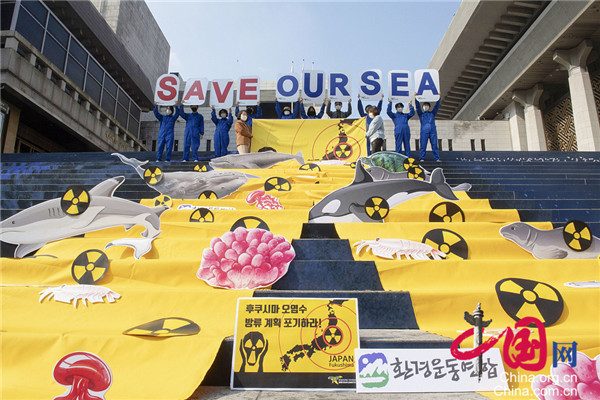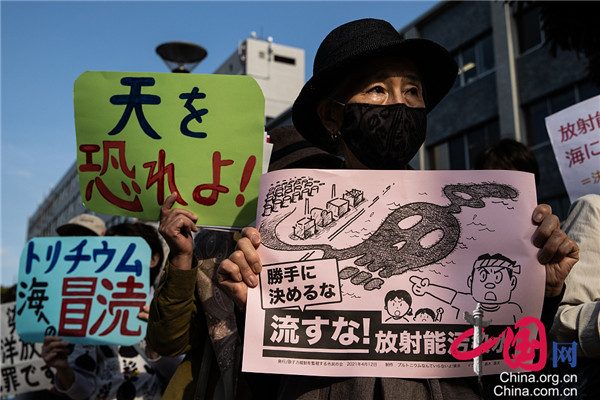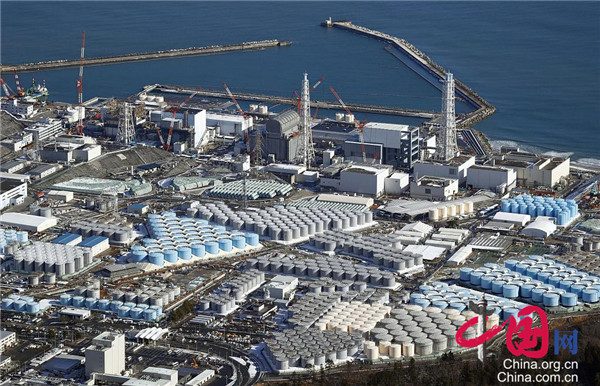May 6 2021, film “Wandering Earth” has such a paragraph: “Initially, no one cares about this disaster, but a mountain fire, a drought, the extinction of a species, the disappearance of a city, until this disaster is closely related to each of us …”
At the moment, the Japanese government seems to be becoming the initiator of a disaster.
In March 2011, a magnitude 9 earthquake and the ensuing tsunami caused a nuclear spill at the Fukushima Daiichi nuclear power plant operated by Tokyo Electric Power Company, one of the world’s worst nuclear accidents to date, on the same scale as the Chernobyl nuclear accident.
If the nuclear accident caused by the earthquake is a “natural disaster”, then the future Japanese government is bent on draining nuclear sewage into the sea, which is undoubtedly a “man-made disaster” for all mankind. By then, generations of human beings will have to pay for this Japanese government’s dementia, and no one can do it alone.
Is Japan’s nuclear sewage really safe?
On April 13th the Japanese government unilaterally decided to discharge millions of tons of nuclear sewage into the sea from the Fukushima Daiichi nuclear power plant. This statement was both out of the picture and the public opinion was uproar.
The harm caused by nuclear sewage discharges to the marine environment across regions is universally recognized, although Japan claims that the treated concentrations have been significantly reduced and will not pose a hazard. Individual senior Japanese government officials have even claimed that “these nuclear sewage drinking is fine.”
What is the nuclear sewage discharged from the sea in Japan? Liu Lin, a researcher at the China Atomic Energy Research Institute and chief expert of China National Nuclear Industry Group Co., Ltd., said the sources of nuclear sewage from the Fukushima Daiichi nuclear power plant mainly include water from tsunamis pouring into the plant, large amounts of water used to cool the cores of accident units, natural precipitation and persistent groundwater inflows.
“The main problem facing Japan today is not only to prevent more natural precipitation and groundwater from flowing into existing nuclear sewage, but also to treat nuclear sewage treated with polynuclide removal devices, as well as standing water in reactor plants. Japan’s discharge into the sea is treated by a polynuclide removal device, the main radioactive element in nuclear sewage. Liu said.
It is understood that, because there is no technology to achieve effective treatment of radon, in recent years, Japan has been the nuclear accident sewage after treatment and storage in a large number of storage tanks in the power plant site. As of March 18, 2021, a total of 1.25 million tons of treated nuclear sewage will be stored on site. Storage tank capacity is expected to reach 1.37 million tons by the summer of 2022.
Is Japan’s nuclear sewage really safe? Zhou Wei, a professor at the Law School of Chinese Min University, said Japan intends to discharge not sewage from nuclear reactors when they are operating normally, but highly hazardous pollutants caused by direct contact between nuclear fuel and water due to nuclear accidents and other causes.
According to data released by Japan’s Tokyo Electric Power Company, the Fukushima nuclear power plant after secondary treatment of nuclear contaminated water, still contains radon, iodine-129, radon-135, carbon-14 and other 13 kinds of nuclides, of which the concentration of radioactive element radon is about 10 times higher than normal emissions.

Nuclear sewage into the sea will affect all mankind
The Japanese government claims that nuclear sewage is discharged in its own country, but that a large amount of radioactive material in nuclear sewage will inevitably have cross-border effects, driven by ocean currents, magnitudes, migratory fish, etc., and thus affect all mankind.
The calculations by a German marine scientific research institute show that within 57 days from the date of discharge, radioactive material will spread to most of the Pacific Ocean, and three years later the United States and Canada will be affected by nuclear pollution.
Quan Yongbo, a professor at Zhejiang Ocean University, said it was certain that nuclear sewage discharges would cause harm to the marine environment across regions. Monitoring data from relevant departments show that since the Fukushima nuclear accident in Japan, China’s fisheries and aquaculture industry has had a great impact. In particular, ballast water brought into China by international ships has caused serious harm to the surrounding sea environment.
In his view, in response to the Japanese nuclear sewage discharge incident, we should fully consider and assess the nuclear sewage discharge on the development of the marine cause of harm.
Regarding the decision of some Western countries to support the entry of Japanese nuclear sewage into the sea, Quan Yongbo said it could be geopolitical, “some countries support Japan’s decision on the one hand and stop importing some Japanese seafood on the other.” ”
“China, as a neighbor of Japan, has the right to raise objections. China and Japan have water, but they can’t bring a coat of sewage. In order to safeguard international environmental interests, the United Nations should be reminded and the international community should work together to stop Japan’s illegal emissions. Zhou said.
Hong Tao, director of the Energy Research Office of the Institute of Resources and Environment of the Development Research Center of the State Council, told China.com that from the Fukushima nuclear accident 10 years ago to the issue of nuclear sewage discharge, the initial global problem is a complex issue interwoven with energy, economy, environment and security, which will inevitably lead to serious concerns in all countries of the world.

How should the international community respond if Japan is bent on doing so?
Zhou said that under international law, illegal discharge of nuclear sewage is fully consistent with the transboundary movement of hazardous waste. In accordance with the Basel Convention and EU law, this involves organized crime, which also leads to the problem of the difficulty of criminal law (the grounds and judgements on which legal liability should be and can be assumed), so it is necessary to introduce the principle of non-difficulty in criminal law and to analyse Japan’s capacity for liability, intent or negligence, and normal accompanying traits.
Quan Yongbo said that in response to this matter, more international agencies should be involved in obtaining authoritative data and analysis and interpretation, so as to ensure the safety and authority of nuclear sewage discharge. International agencies can consider certain economic penalties and sanctions if there is a greater harm and Japan still emits emissions.
As to why the Japanese government discharges nuclear sewage into the sea, the Japanese side explained that “the tank can not be put down”. There is international speculation that the Japanese government’s aim is to save money.
It is understood that for the treatment of these nuclear sewage, Japan’s report to the IAEA and the road map for the decommissioning of nuclear power plants show that the Government of Japan has drawn up five options for pumping deep underground, discharge into the ocean, evaporation release, electrolysis into hydrogen release and solidification into the ground.
In the end, the Japanese government chose the simplest and lowest-cost way to discharge directly into the sea, and the most costly way is to solidify it into the ground, estimated to cost dozens or even hundreds of times as much as the discharge into the sea.
In this regard, Zhou said that if Japan has the technology and capacity to treat nuclear sewage, but only to save money to choose the direct discharge of the sea, the nature of the pursuit of illegal interests to carry out environmental crimes, but also because of cross-border transfers, in accordance with EU law is organized crime.
Zhou said that although the acts enumerated in international conventions do not include sewage from nuclear accidents, and existing international law does not provide for such acts directly and explicitly, this does not mean that international environmental law cannot apply the case, does not mean that Japan’s international environmental responsibilities can be exempted, let alone as a reason for Japan’s discharge.



